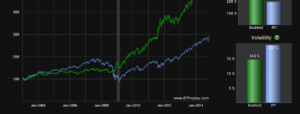The monthly housing numbers for October start rolling in next week, which will renew the focus on the key question: Is this crucial sector of the US economy still a risk factor for the business cycle? Recent data looks a bit more encouraging vs. the softer trend from earlier in the year, but housing’s growth remains sluggish compared with the robust gains in 2012 and 2013. For the moment, however, the worst fears have receded, although it’s still unclear if the trend will stabilize at a lesser growth rate. We’ll have a clearer picture of what lies ahead after the next batch of figures arrive, starting with next week’s update (Nov. 19) on new residential construction. Meantime, let’s review how the numbers stack up on three key indicators: new home sales, existing home sales, and housing starts, followed by a look at the outlook for prices.
Measured by year-over-year changes, starts and sales of newly built units have rebounded moderately after dipping into negative territory earlier this year. But the good news is mixed at best. Indeed, existing home sales, which dominate transaction activity, are still falling in annual term, although the numbers seem to be showing tentative signs of rebounding.

Factors that imply that housing overall will remain a net positive for the economy include low mortgage rates and persistent growth in US payrolls of late. But the outlook for construction remains subdued, according to the October sentiment reading for homebuilders. The National Association of Home Builders/Wells Fargo Housing Market Index (HMI) eased a bit in October to a moderately positive 54 after reaching a nine-year high in September.
“While there was a dip [in October], builders are still positive about the housing market,” said NAHB Chief Economist David Crowe last month. “After the HMI posted a nine-year high in September, it’s not surprising to see the number drop in October. However, historically low mortgage interest rates, steady job gains, and significant pent up demand all point to continued growth of the housing market.”













Leave A Comment